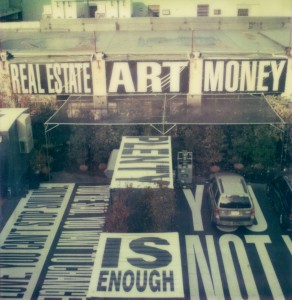These are transformational times for creative practice. While the backdrop of funding cuts and reduced consumer spending is undoubtedly causing challenges for artists, incredible new opportunities are also opening up, especially for those willing to embrace the world of business. New technologies such as personal manufacturing, open source software and free online tools are pushing the boundaries of what is achievable, and creative practitioners are well-placed to take advantage of this. From artists starting up their own micro-businesses right through to big corporations recognising the value of creativity in the innovation process, new relationships between artists and enterprise are taking shape.

Image: Anne Bowerman. Licensed under Creative Commons License 2.0 :: http://creativecommons.org/licenses/by-nc-nd/2.0/
Artists, as ever, are driving many of these changes. Emerging technologies not only provide new tools for creation of artworks, new platforms for sharing and collaborating, and new ways to reach a broader audience, but they also open up innovative business models that artists are able to use to build sustainable practices.
One of the most significant technological developments is what Wired magazine has described as “the new industrial revolution”[1]. A radical shift in manufacturing is taking place, one that takes control away from the traditional manufacturers and places it in the hands of the creators themselves. From supply of small quantities of materials right through to on-demand manufacture and direct-to-consumer sales, the rise of personal manufacturing is revolutionising the way new products are brought to market.
A few examples include:
Design: Google’s free SketchUp tool allows intuitive 3D modeling; similarly, Blender offers an open source 3D content creation suite.
Materials: Inventables, the “innovator’s hardware store” was set up in response to the difficulty that artists and inventors often have in sourcing small amounts of materials. Its online store offers a broad range of supplies, from raw materials such as acrylics and ceramics right through to complex electrical components, allowing a low-cost solution for prototyping and testing of concepts.
3D Printing: personal fabrication service Shapeways allows individuals to submit their designs online; it then prints these out using state-of-the-art 3D printers and mails the end product back to the designer. The Shapeways Shops allow artists to sell their designs direct to the public. Inventory is kept to zero as orders are printed on demand. All the artist needs to decide on is how much mark up to charge – the processes of ordering, payments, production process, customer service and shipping are all taken care of by Shapeways.
Artists can also choose to 3D print their designs themselves – Makerbot Industries now sell the ‘Thing-o-matic’ desktop 3D printer for around $1300. The machine is sold via mail order in kit-form, allowing any home or workplace to be transformed into a small-scale factory.
Online Marketplaces: sites such as Etsy, the “world’s handmade marketplace” and Ideacious, the “community-based venue that determines demand before supply” allow artists to sell their works direct to a growing global consumer market.
The rise of personal manufacturing is transforming the speed of innovation – a new product can now be conceptualised, designed, prototyped, manufactured, and marketed direct to consumers within a matter of weeks. A further benefit is that with fewer middlemen involved, more revenues flow through to the creators themselves.
Big businesses too are becoming more aware of the positive effects on innovation that can be had from integrating creativity into business processes. The 2008 NESTA publication “Creating Innovation” shows that businesses in the UK that have a strong link with the creative industries “are 25% more likely to introduce product innovations either new to their firm or to their market”[2]. In the US, more than 400 of the Fortune 500 corporations employ arts-based learning in some form[3]. This ranges from simple arts-based activities for training and development, right through to a much deeper engagement in which creativity is identified as being the catalyst that stimulates innovation, opens up communication, and allows business to rethink itself. AMP is pioneering this approach in Australia. Their biennial AMPlify Festival brings some of the world’s foremost thought-leaders to Sydney to explore “the edge of business innovation and ideas” with an audience including staff, partners and members of the public. The “Creativity Tapas” program at the festival provides employees with hands-on learning workshops in a range of creative and performance-based arts.
ANAT too has long explored the intersections between art, technology and business (see for example Filter 74 ”Sustainable Creative Practice”). It has recently established a Business Development department to support its vision “to provide a trans-disciplinary platform to integrate artistic and creative practice into research, development and enterprise across science, technology, communities and industry”. A new “Enterprise” section will be launched soon on the ANAT website, with more information including some useful resources to assist creative practitioners to achieve financially sustainable practices. In the meantime, please feel free to contact ANAT Business Development directly with any ideas or comments.
Karen Marsh
ANAT’s Business Development Manager Karen Marsh has many years of business development, marketing and commercialisation experience, spanning the creative industries, multinational corporations, and academia. Her most recent role was as a commercialisation consultant at Flinders University in South Australia. Prior to this, she worked in international business development roles in London at Sony Pictures, EMI Music, and Universal Music.
References
[1] Chris Anderson, Wired Magazine, 2010
[2] “Creating Innovation: Do the creative industries support innovation in the wider economy?”, NESTA, 2008
[3] http://en.wikipedia.org/wiki/Arts-based_training
 This work is licensed under a Creative Commons Attribution-NonCommercial-ShareAlike 3.0 Australia.
This work is licensed under a Creative Commons Attribution-NonCommercial-ShareAlike 3.0 Australia.






